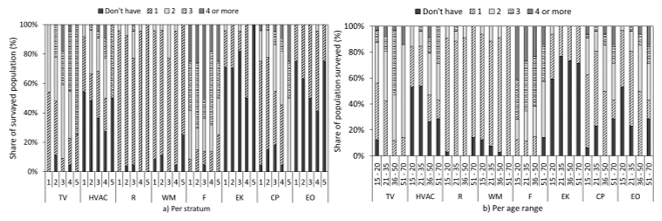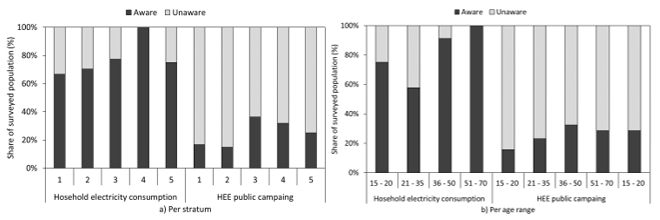Introduction
The residential demand for electricity accounted for 26 to 28% of the global consumption between 1990 and 2019 (IEA, 2022), while in Colombia reduced from 42% in 2006 to 39% in 2015 (UPME, 2022). However, different barriers, like misplaced incentives, lack of awareness and information, market-related barriers, and financial barriers, preclude the implementation of frequently profitable HEE (Bianco and Sonvilla, 2021).
Considering reference efficiency or the best available technology efficiency, the residential final energy consumption (including all energy sources) can be reduced by 56 to 70% (UPME et al., 2019). Particularly, electricity accounts for 31% of the energy mix in the residential sector, wood accounts for 46%, and natural gas for 17%. Most of this saving potential is related to the use of wood for cooking, mainly in rural areas (UPME, 2020). Overall, the saving potential is estimated at 145,996 to 182,321 TJ, equivalent to 1,643 to 2.357 million USD (UPME et al., 2019).
In Colombia, cities are categorized into 6 strata according to their income. Strata 1 to 3 account for 84% of the residential electricity consumption, averaging 566 kWh per capita, while strata 4 to 6 account for 16 of the residential electricity consumption, averaging 1,577 kWh per capita (DANE, 2018; UPME, 2019). In particular, the Atlantic Department has the highest residential electricity consumption per capita in the country (DANE, 2018; UPME, 2019), mainly because of the extensive use of HVAC systems for air conditioning. Moreover, the cost of electricity in the city increased by 62.5% since 2021 (Alcaldía de Barranquilla, 2022). Consequently, introducing household energy efficiency (HEE) measures in the residential sector in Barranquilla is instrumental in achieving sustainable development.
Household energy efficiency (HEE) is promoted through different approaches, including fiscal incentives, access to finance, grants, subsidies, pricing tariffs, rewards, advertising, workshops, modifying social norms, behavioral change interventions, demonstration projects, household engineering modifications, energy audits, and the combination of activities (McAndrew et al., 2021). Defining which of these approaches is the most adequate to promote HEE is a cornerstone for policymakers since using new and more efficient technologies does not guarantee higher efficiency standards when household users are unaware of how to use them efficiently (McAndrew et al., 2021). It is indicated to implement segmented and targeted HEE interventions to impact a broader and more diverse range of population groups while considering aspects like comfort, health, and well-being (McAndrew et al., 2021).
Public communication campaigns, which can be defined as “planned attempts to change specific behaviors in targeted audiences within specific time frames, through different communication activities aiming at advertising particular messages to produce benefits to individuals and society”, are one main tool to promote energy saving in general (Borawska et al., 2022). While different studies show the positive impact on energy savings resulting from positively modifying human behavior, there are different barriers precluding traditional media campaigns from using simple dissemination of information to achieve lasting behavioral changes. In general, communication campaigns aiming at energy conservation targets promote changes in individual consumer behaviors by presenting more efficient behavior patterns and habits. For example, in Ireland, a campaign based on one leaflet attached to customers’ bills motivated a reduction in natural gas consumption from 1.6% to 2.1% in one year (Diffney et al., 2009). Moreover, an HEE campaign to introduce low-cost or no-cost measures in low-income households in households averaging around 2000 kWh per annum, found that letters and in-home displays were the preferred systems to receive consumption feedback, while environmental factors and money were the main motivations for energy-saving (Vassileva and Campillo, 2014).
An important aspect of campaigns to deal with consumer diversity is segmenting larger heterogeneous population groups into smaller more homogenous subgroups (i.e., groups similarly responding to commodities and marketing messages) (Moss and M.Cubed, 2008). This addresses the necessity to communicate and motivate action more effectively within an increasingly heterogeneous population relying on a rapidly growing number of communication channels. Some characteristics of households, mainly for low-income families, must be considered (Moss and M.Cubed, 2008):
Might not own their households
Use old or inadequate equipment
Are poorly educated on energy uses
Have little time to manage their energy use.
This study aims at identifying and necessity and adequate approaches for an HEE campaign in the city of Barranquilla.
Materials and methods
The success of communication campaigns depends largely on the message (Wymer, 2011). Pretesting the different campaign messages requires the use of different methods to assess the impact of messages on the target audience, identifying the more effective elements to communicate and influence positive behavioral patterns and habits and technology modifications depending on the campaign goals (Lee and Kotler, 2020; Nedra Kline Weinreich, 2011). This study uses a survey to identify the awareness level of citizens regarding HEE. Moreover, the survey looks for the most adequate communication channels to reach different population groups depending on their stratum and age range and which messages are more indicated. Table 1 shows some considerations used to develop the survey.
Table 1 - Indicators for assessing the effectiveness of the communication campaign (Source: Borawska et al., 2022).
| Indicator | Measure | Tools |
| Awareness |
Share of individuals showing awareness of HEE |
Audience surveys |
| Engagement |
Share of individuals involved in debates and dialogues around HEE. Share of individuals taking action to complement their knowledge of HEE |
Audience surveys Behavioral data (e.g., website hits) |
| Behavioral change |
Share of individuals reporting behavioral changes |
Audience surveys |
| Social norm |
Share of individuals with positive attitudes towards the HEE campaign |
Audience surveys Observations |
| Wellbeing |
Share growth in the social outcome. Share growth in the environmental outcome |
Epidemiological data Environmental data |
Source: own elaboration
Results and discussion
Following, the results of the surveys applied are discussed. Fig. 1 shows the awareness of household electricity consumption and HEE public campaigns in the city.
Results show that 60% to 100% of people are aware, mainly in 36 to 50 years and 51 to 70 years. However, less than 40% of people know public campaigns promoting HEE.
Figure 2, shows the level of awareness and interest in HEE campaigns.
Results show that in strata 4 and 5 (with the highest costs of electricity), over 70% of the population always monitors electricity consumption. Moreover, from 22 to 50% of the population implements HEE measures.
Figure 3 shows the main motivations considered for implementing HEE measures.
Results show that the cost of electricity is the main reason driving the implementation of HEE measures in all age ranges, while climate change is significant mainly in strata 3, 4, and 5.
Results show that the cost of electricity is the main reason driving the implementation of HEE measures in all age ranges, while climate change is significant mainly in strata 3, 4, and 5.
Figure 4 shows the most implemented measures on households in the city.
Results show that replacing old equipment is the main HEE strategy except for people between 51 and 70 years old. Other HEE measures are less implemented.
Figure 5 shows the main equipment available in households.
 * R - refrigerator, WM - washing machine, F - fans, EK - electric kitchen, CP - computers and printers, EO - electric oven
* R - refrigerator, WM - washing machine, F - fans, EK - electric kitchen, CP - computers and printers, EO - electric ovenFig. 5 - Household electro-domestic equipment
Results show that 96% of the people have a TV, while 58% have HVAC systems for air conditioning. Moreover, 98% of the people have refrigerators, 93% have washing machines, 30% have electric kitchens, 90% have computers and printers, and 41% have electric ovens.
Fig. 6 shows the main information channels used by people in the city.
 * SM - social media (Facebook, Twitter, Instagram, WhatsApp), WEB - digital newspapers and blogs, R - radio, NP - newspapers
* SM - social media (Facebook, Twitter, Instagram, WhatsApp), WEB - digital newspapers and blogs, R - radio, NP - newspapersFig. 6 - Information channels used.
Results show that social media and the WEB are the main information channels used, predominantly among younger people. Other channels like the radio, the newspapers, and TV are generally less used. Older people in higher strata show the highest use of these systems in these cases.
Overall, between 67 and 100% of the people surveyed in different strata are interested in learning more about how to improve HEE.
Conclusions
This study shows the need for an HEE campaign in the residential sector in Barranquilla. The study concludes that the campaign must focus on social media and WEB communication channels. Additionally, the campaign needs to focus on efficiency strategies for HVAC air conditioners, refrigerators, and lighting systems. Moreover, since the cost of electricity and climate change are the main motivators for energy saving, the measures proposed in a campaign should be associated with cost and carbon footprint savings.


















